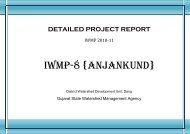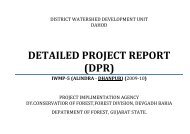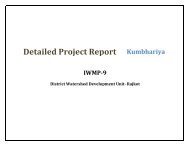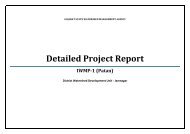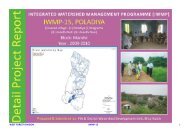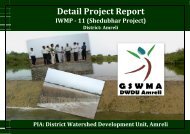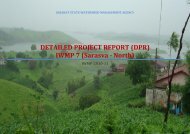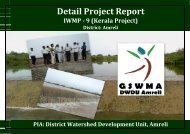IWMP-2 - Commissionerate of Rural Development Gujarat State ...
IWMP-2 - Commissionerate of Rural Development Gujarat State ...
IWMP-2 - Commissionerate of Rural Development Gujarat State ...
You also want an ePaper? Increase the reach of your titles
YUMPU automatically turns print PDFs into web optimized ePapers that Google loves.
Detailed Project Report <strong>IWMP</strong>-2<br />
Soya bean crop cycle<br />
Soya is a short-day plant, and is sensitive to day length. It flowers when the day length is shorter than 16 hours. Short-cycle varieties flower 30-35 days after sowing<br />
and ripen within 75-105 days. These varieties have low yields. The middle-length varieties also flower 30-35 days after sowing and mature within 110-140 days.<br />
These have good yields. The long-cycle varieties produce a large amount <strong>of</strong> leaf material.<br />
Soil conditions<br />
Soya grows best in soils that are not too light and not too heavy in texture. Soya does not germinate easily in heavy clay soils, although it does grow well in them<br />
after germination. If a heavy soil has been well prepared it is preferable to a light sandy soil, as the yields are likely to be more certain. Soya grows well in soils with<br />
high organic material content. Soya prefers a pH <strong>of</strong> between 5.8 and 7.8, and does not like alkaline or acid extremes. Soya will not tolerate saline soils.<br />
Water requirements<br />
Soya has two critical periods concerning water requirements: from sowing to germination, and the period during which the beans grow in the pods. Before a seed<br />
can germinate it needs to absorb 50% <strong>of</strong> its weight in water. Nevertheless during the germination phase too much water causes more damage than too little water.<br />
The soil needs to be between 50% and 85% saturated with water. The amount <strong>of</strong> water needed increases as the crop grows, reaching its maximum as the beans<br />
develop in the pods (7-8 mm per day), and then decreases again. To be sure <strong>of</strong> a good yield, soya needs between 450 and 800 mm water each day during its whole<br />
growth cycle, depending on the climate. In high temperatures more water evaporates, so more water is needed to provide the crop with enough water. So Drip<br />
Irrigation is the best option for sufficient water requirement.<br />
Cultivation <strong>of</strong> Soya<br />
Soy is a kharif crop, sown in June-July and harvested by September-October. Peak arrivals are from October-November. Soya is a frost-sensitive summer annual, and<br />
it takes about 75-105 days for the beans to fully mature; plants may reach 1 metre high. Seeds are borne in hairy pods which grow in clusters <strong>of</strong> three to five; each<br />
pod contains two or three seeds, which resemble peas. When the seeds are mature, the upright vine and foliage begin to shrivel and the leaves fall away. Harvesting<br />
by machine must be completed before the pods shatter. Farmers <strong>of</strong>ten know a lot about local varieties and the conditions under which they grow well. They <strong>of</strong>ten<br />
grow different varieties <strong>of</strong> the same crop in order to spread their risks. Main varieties <strong>of</strong> soya bean are Punjab-1, Braig, Ankur, Gaurav and Jawahar.<br />
<strong>Gujarat</strong> <strong>State</strong> Watershed Management Agency<br />
126 | P a g e



